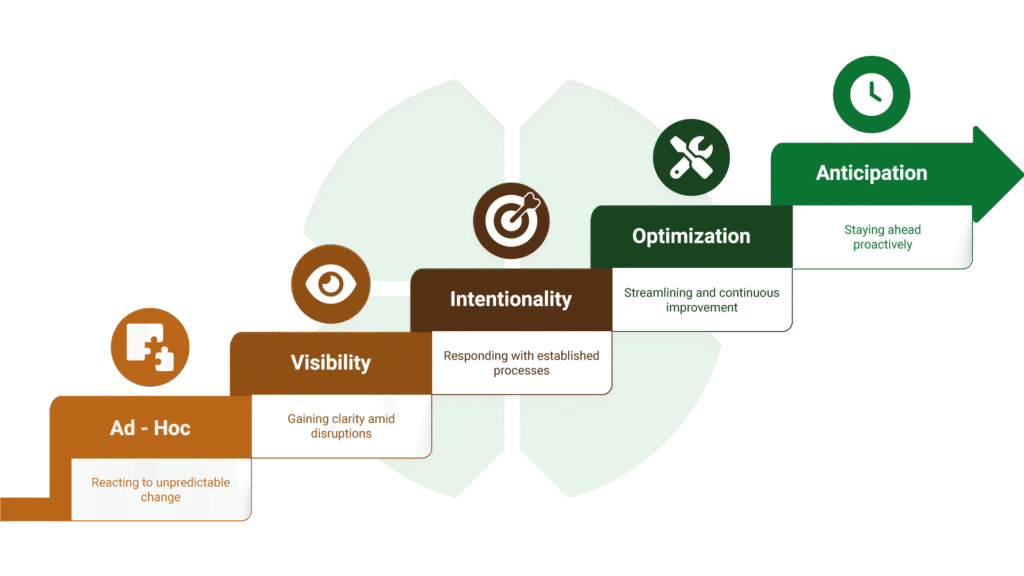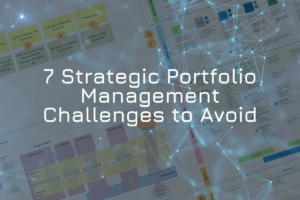Organizations today face unprecedented complexity and relentless change. Portfolio design maturity is not merely about selecting projects or distributing resources—it is fundamentally about an organization’s capability to navigate and respond effectively to continuous change. Assessing your portfolio design maturity can significantly enhance your organization’s readiness and adaptability, empowering teams to confidently face tomorrow’s challenges. This article explains the concept of maturity in strategic portfolio management, contrasts it with traditional compliance-driven assessments, and highlights practical ways to evaluate and enhance your organization’s maturity level—addressing common strategic portfolio management challenges.
Maturity: More than Compliance
Traditional assessments often emphasize compliance—verifying adherence to predefined processes, standards, or practices. While valuable, compliance-based assessments tend to overlook the critical underlying capability: your team’s ability to handle change effectively. True maturity in strategic portfolio management is less about whether specific methodologies are followed rigidly, and more about your organization’s collective responsiveness and agility in managing change.
In other words, assessing maturity in portfolio design—as we have come to define it—is about evaluating what your organization can do rather than merely checking what it currently does. It provides a forward-looking view of capabilities rather than a backward-looking audit of processes.
Understanding Portfolio Design Maturity Levels
At its core, strategic portfolio management maturity indicates how proficiently and proactively an organization can sense, interpret, and manage disruptions or shifts—be they market changes, technological advancements, customer preferences, or internal organizational dynamics. A more mature strategic portfolio management capability means your teams are increasingly adept at managing uncertainties without descending into crisis.
Higher maturity implies:
- Enhanced Visibility: Clear insight into ongoing work and impending changes.
- Intentionality: Deliberate, strategic responses rather than reactive firefighting.
- Optimization: Continuous improvement in responding to disruptions.
- Anticipation: Early recognition and preemptive management of future changes.
The ultimate goal is a proactive, resilient organization capable of turning challenges into strategic opportunities.
The Xodiac Maturity Model: A Practical Lens
The Xodiac maturity model offers an effective approach to assess and enhance strategic portfolio management maturity, emphasizing your team’s responsiveness to change across five evolutionary states:

Ad Hoc
In the Ad Hoc state, organizations react spontaneously to change. Prioritization is inconsistent, and crises frequently disrupt workflow. Success depends heavily on individual heroics rather than collective processes. Teams operating in this state often experience burnout, inefficiencies, and high vulnerability to unexpected disruptions.
Visibility
Visibility provides teams clarity about ongoing tasks and emerging issues, although this clarity doesn’t guarantee immediate resolution. Teams may still approach new disruptions as urgent crises, but the improved transparency significantly reduces unnoticed impacts. Leaders in this state elevate concerns promptly, ensuring relevant stakeholders are informed swiftly.
Benefits at this stage include:
- Understanding true costs and asset impacts.
- Improved decision-making clarity.
- Clear accountability.
Intentionality
In this state, organizations respond confidently and methodically to disruptions. Rather than panic-driven actions, changes trigger controlled responses guided by established prioritization and communication processes. Effective leadership empowers informed decision-making at all organizational levels.
Benefits of intentionality include:
- Focused efforts aligned with business goals.
- Predictable results through process-driven responses.
- Effective operational risk management.
Optimization
Optimization represents continuous improvement and efficient handling of disruptions. Responding to changes is part of routine operations rather than anxiety-provoking exceptions. Teams leverage retrospectives, data-driven insights, and collaboration to rapidly resolve disruptions, optimizing delivery speed and quality continuously.
Benefits of optimization include:
- Cost-efficiency.
- Accelerated problem resolution.
- Enhanced operational quality.
Anticipation
At the pinnacle of maturity, anticipation allows organizations to proactively interpret signals of impending changes, preventing issues from escalating into disruptions. Organizations in this state don’t merely respond; they strategically lead change by introducing innovations that preemptively address future challenges.
Benefits include:
- Revenue growth through innovation.
- Market disruption capabilities.
- Proactive business development.
Connecting Portfolio Design to Strategic Success
Portfolio design maturity assessment deeply connects to portfolio design’s core concerns—visibility, strategic alignment, and adaptability. Consider visibility: achieving it means your portfolio clearly identifies current investments, understands resource allocation, and monitors evolving risks. Intentionality ties directly to prioritization and strategic alignment, ensuring efforts match organizational goals. Optimization and anticipation push this further, focusing on innovation, cost-effectiveness, and proactive adaptation to market shifts.
Evaluating maturity thus offers insights directly relevant to common strategic portfolio management challenges, such as:
- Misaligned investments and strategy.
- Poor resource allocation.
- Frequent disruptions and reactive responses.
Each maturity level offers increasingly refined solutions to these pervasive problems.
While portfolio design maturity is assessed holistically, it can also be evaluated specifically across several critical organizational dimensions. Assessing these areas separately allows you to pinpoint exactly which parts of your organization need the most attention, guiding targeted improvement efforts and ultimately enhancing your overall ability to achieve strategic success:
- Delivery: Focus efforts on responsive and efficient value delivery.
- Product: Adapt offerings proactively to changing market conditions and customer needs.
- Culture: Strengthen values and behaviors to support agility, collaboration, and continuous improvement.
- Vision: Clarify and align operational activities with the organization’s future direction.
- Governance: Balance control with flexibility to enhance strategic agility.
- Structure: Refine organizational design to enhance adaptability and execution.
- Platform: Optimize technical infrastructure to support agile, scalable, and reliable delivery.
Conducting Your Maturity Check
Begin assessing your organization’s maturity level through practical, team-centric approaches, such as the sample online Xodiac maturity assessment tool available at landing.xodiac.ca/maturitymodel, which gives you an introduction to our comprehensive assessment framework. This tool leverages a sensing framework, focusing on your team’s perceptions and real-world responses rather than rigid compliance criteria.
Using the tool involves:
- Evaluating current handling of changes and disruptions.
- Identifying visibility into portfolio activities.
- Analyzing intentionality behind strategic decisions.
- Reviewing processes for continuous optimization.
- Assessing organizational foresight and proactive innovation.

The results provide clear indicators of your current maturity state, practical implications, and actionable insights to evolve further.
The online portfolio design maturity assessment provides a lightweight overview to quickly gauge your organization’s current maturity state. However, a full, comprehensive assessment will individually evaluate all key dimensions—Delivery, Product, Culture, Vision, Governance, Structure, and Platform—to offer deeper insights and more actionable recommendations. To explore this detailed assessment and effectively pinpoint areas requiring attention, please contact Xodiac directly.
Taking Action: Enhancing Your Maturity
Once your maturity level is clear, leverage the findings to target improvement efforts strategically. Actions may include:
- Improving Visibility: Invest in tools and processes for clearer portfolio tracking and communication.
- Enhancing Intentionality: Formalize and strengthen strategic alignment practices and reprioritization processes.
- Driving Optimization: Encourage continuous improvement and foster a culture of retrospectives, feedback loops, and collaboration.
- Fostering Anticipation: Promote innovation, experimentation, and proactive risk mitigation to build an adaptable, forward-thinking portfolio.
Regularly reassessing your portfolio design maturity ensures continuous evolution and improvement, keeping your organization resilient and ready for tomorrow’s challenges.
Conclusion
Assessing your strategic portfolio management maturity equips your organization with critical insights into capabilities and readiness for future challenges, beyond simple compliance measures. By leveraging frameworks like Xodiac’s maturity model, organizations can pragmatically evaluate their current state, understand their responsiveness to change, and strategically evolve to higher maturity levels. In doing so, they position themselves not merely to react to change but to thrive amidst it, confidently steering their strategic portfolio management toward sustained success.
Sustaining Excellence: Your Journey Toward Portfolio Mastery
As we conclude this Portfolio Design series, remember that achieving excellence in portfolio management is an ongoing journey rather than a final destination. Through 17 articles, we’ve explored foundational principles, strategic frameworks, practical tools, and real-world applications—all aimed at enhancing your organization’s agility, resilience, and capacity for proactive change. Embrace continuous learning, encourage experimentation, and regularly assess your maturity to ensure sustained alignment with your strategic vision. Armed with this holistic approach, your organization is well-equipped not only to manage today’s complexities but to confidently and effectively shape tomorrow’s successes.





